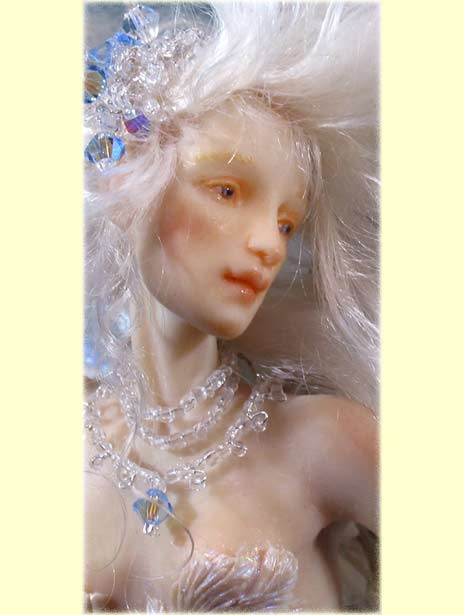
Just a quick image...

Just a quick image...

Soon I’ll construct a links page to at least a few of the many, many artists other persons whose work and sites I love, and who provide constant inspiration.
But today, off to answer the cries of heaps of unfinished things in the 3-D universe, and clean up, and...
Thank you for visiting me, kind Friends!
Anon,
F.

...or, making strong 3-D spiky things in polymer clay. This figure would stand about 8 inches in stocking feet. She flew to her new home via eBay, arriving undamaged.
My motto: Look like a butterfly, ship like a tennis ball.
To achieve this, one first needs a strong material. Amongst polymer clays, I recommend Kato Polyclay, Classic Fimo and Puppen Fimo. I understand Cernit is also quite strong, but I’ve not worked with it. No doubt there are others: experiment, and check out the enormous polyclay reference site, Glass Attic:
http://www.glassattic.com/
To test clay strength, I roll little ‘snakes’ (worms, if you prefer) as thin as my thinnest planned finger, tail, or other appendage, and bake them thoroughly. Then I set about bending and snapping them. Most informative. And I always make sure to cure a clay as long and hot as the manufacturer suggests. Under baked polymer clay is like ceramic greenware -- very fragile. Kato clay and the Fimos mentioned above all take long, repeated baking very well, though there may be some colour shift. Again, experiment.

Armatures: I armature everything, including fingers (many achieve beautiful fingers without armature, but... well, I need something to press against). Overall, an armature strengthens and supports, and in these winter faeries, each protrusion is built over wire. I now use a gold-plated or gold-filled wire, as this seems to help prevent verdigris. And for a tiny critter, it’s not too expensive.
To help the polymer clay adhere to the wire, I paint it with Gem-tac glue. That’s a white glue, that happens to be particularly good a clinging to nonporous surfaces. Sobo would do as well, if you can get it to cover the wire. I let the glue dry on the armature. The polyclay adheres well with dried white (PVA) glue.
Another good armature material: Aves Apoxie Sculpt, Fixit or Fixit Sculpt. Read about them at the Aves site: http://avesstudio.com/
I’m partial to the Fixit Sculpt. I cover an armature with it, then coat it with a PVA glue, as above. The polymer clay adheres well, is supported during baking, and, thus far, I’ve not had cracking problems (I watched for this, given the possibility of varied shrinking/cooling rates).
But enough for now. E-mail me if you have a question about this, and, despite cultivating a fashionable degree of ADD, I’ll aim to answer! Soon. Really.

A winter faery (or fairy, or fay, or faerie).

This figure is in Kato Polyclay (a polymer). She would measure about 8 inchs tall, were she standing.
Thus, her head actually measures about 1 inch.

...who was on eBay. I must away to the work table, but I've added a few images to the Mermaid Gallery. More to come... one can never have too many mermaids.

Hello Friends...
Here’s Water Lily Mermaid, who appeared on eBay under my ‘ForestBeings’ I.D. She would stand about 8 inches tall, if she had human legs. She’s sculpted in Kato Polyclay. Soon as I can (this blog is a proving a superb Avoidant Activity; I must ration the time spent) I’ll add some favorite sculpting supply links to this page. And... well, we’ll see. Back to the sculpting table...

This Swan Maiden was inspired by the tale "The Fate of the Children of Lir." I was fortunate enough to travel to Ireland, and see some of the areas associated with this story (more on travels with Jungians when I have my brain polished up).


Here we have a pair of beings sculpted in Kato Polyclay, and Aves Apoxie Sculpt.
Flidais (the more human of the two) would be about 8 inches tall, standing. She
holds a staff of gold-filled wire, copper foil and goldleaf, with bead berries.
And then there’s social media, of course: